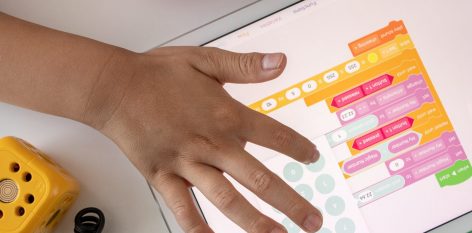Often when I sit down to write, I manage to write quite freely, however I don’t think I’ve ever questioned myself more than when it came to sitting down to write this piece.
At first, I was excited by the opportunity to write this article – what educator wouldn’t want to write about education in the age of COVID! We’ve been recognised as an essential part of keeping whole-country economies alive, providing a safe place for students whilst ensuring an adequate level of engagement in learning is upheld. Phew, no problem. We’re used to chaos right. We’re adaptable, resilient, masters of practicing growth mindset and forever the torch bearers in acknowledging the power of collaboration and teamwork. Aren’t we?
I’ve been in the education game for a while now, starting out as a ski instructor to becoming a support officer for students with Asperger’s Syndrome, followed by a qualified primary school teacher where I taught in both the private and public school systems in Australia and overseas. More recently, I’ve been consulting in learning design and program development both in Australia and the US, leveraging traditional modes of delivery and virtual reality.
COVID has unquestionably left a trail of destruction in its wake and it seems it will continue to do so for many more months, if not years. No person, community or industry has been left unaffected but in the words of Albert Einstein, “In every crisis, there is an opportunity.”
Yes, this should be our time, but is it? Have we been given the space to apply what we call in education, the 5 E method? A constructivist model of learning that includes five stages: engage, explore, explain, extend, and evaluate. It only seems fair that if this is what we ask of our students then we too should apply a similar approach when working through the COVID-19 ‘project’.
It has been intriguing to observe the amount of people who have come up to me and commented on how they’ve found themselves spending more quality time with family, more time outside exercising, more time focussed on creative projects, and they’ve found themselves having more meaningful conversations between friends and even strangers.
Sometimes opportunities can arise without really knowing it and often only after we ‘stop to smell the flowers’ do we take notice.
Unfortunately I can’t say this has been something I’ve noticed when it comes to the state of education in the age of COVID. I do not believe we have been given or have allowed ourselves the chance to stop and smell those flowers, pleasant or not. We most certainly have not engaged, explored, explained, extended or evaluated the current crisis and therefore the opportunities that may or should come from the current situation.
Recently I attended a ‘town hall’ (virtual) meeting, which included a number of school principals all representing schools across the five boroughs of NYC, as well as Newark, USA. It was incredibly heart-warming and insightful.
Three things stood out above all else when these principals were asked to share their observations based on what they’ve noticed pre-COVID to now.
- Home to school connections and genuine interest in learning and respect of teachers by parents has never been stronger nor closer.
- The ability for students to apply a growth mindset, noticed by parents in a variety of (difficult) situations, has left parents astounded.
- Learning management systems that have been developed and refined well before COVID have enabled a near seamless transition to remote-learning and in many cases enabled those students who have struggled to be engaged during on-site delivery to excel.
These three points are so important in so many ways and to not take stock and recognise these in a way that we can learn from and evolve would be a wasted opportunity to say the least. Yet, this is exactly what appears to be happening.
Never have we seen or heard of these three points when reading newspaper articles, watching the news, etc. Never do we see or hear from a students’ perspective. Never do we see or hear from a collective voice composed of teachers, counsellors, or administrators.
We simply have not allowed ourselves to stop and smell the flowers. Instead we bash each other up and shift blame from left to right, up and down. It worries me that we seem to always look for short term solutions (aka gains) that often leave us with long term pains. This finger-snap approach creates an unnecessary level of hysteria, which often clouds our good judgement in order to act on the grounds of responsible decision making.

For months now I’ve been hearing and been asked about the need for a COVID-response solution. A solution to what exactly? A solution in response to the massive decline in student engagement due to the introduction of remote learning? News flash, according to Gallup, a global analytics and advice firm that helps leaders and organisations solve their most pressing problems, our educational system sends students over the school cliff every year.
In 2013 the Gallup Student Poll surveyed nearly 500,000 students in grades 5 through 12 from more than 1,700 public schools in 37 states across America in 2012. What this survey found was that nearly 8 in 10 elementary students who participated in the poll are engaged with school. By middle school that falls to about 6 in 10 students. And by high school, only 4 in 10 students qualify as engaged. In a nutshell, student engagement has been in decline well before COVID.
According to the Australian Curriculum, Assessment and Reporting Authority (ACARA) 2019 report, the number and proportion of all students enrolled in schools by school level and school sector was 3,948,811. Like any big business facing historical levels of uncertainty, this is no small feat but any need for change, whether it be in a response to a pandemic or not, requires time. It requires engagement, exploration, explaining, and evaluation, not sweeping statements that are quick to place blame on another or shift attention away from the real issues, including small but relatively significant good news stories.
Based on my observations and from listening to those on the front line, early indicators suggest an element of success has come from this ‘experiment’. Is there room for improvement? Of course. Has a gaping hole of inequity been uncovered? Absolutely. These are serious issues and they need to be addressed, however these issues sit well outside the wheel house of educators, schools and community. It must be addressed at a whole-systems level.
We must use this time in crisis to look toward new horizons, new opportunities. How do we do that? Where do we begin? By starting the conversation. By inviting all stakeholders to the party, young and old.
What do we do when we fall down? What do we do when we fail or find ourselves in trouble? We get back up. We listen. We learn. We ask for help. We come together as a community to become the change agents that we need to enact systemic, meaningful change. All of this takes time.
It is important we use this time for learning and development.
Video conferencing has been around since the 1970s, the World Wide Web (www.) since 1980, Google Classroom since 2014 and Microsoft Teams since 2017. We must not place blame on technology, teachers, parents, students and others. We must focus our attention on the system that is broken and needs fixing, not a COVID response-solution.
We have the means to deliver but do we have the genuine interest, patience and grit to deliver on the change required? Change that promotes positive dispositions for learning? Not to mention, courage and curiosity, trust and playfulness, perseverance, confidence and responsibility.
We hear over and over again about the need to promote 21st-century learning skills to support the jobs of the future. Well, perhaps it is time that we, being the adult community, actually stop to smell the flowers and act on what it is that we are actually saying when we slap slogans and catchphrases all over our pitch decks.
As Winston Churchill famously said, “Never let a good crisis go to waste”.
Primary-aged students need much more attention and we should value time for social interaction, especially having them attend school in person. However, the implementation of synchronous integrated learning management systems, such as a Google Classroom or Microsoft Teams, should be adopted, with sufficient teacher training, in order to prepare students for remote learning once they enter their middle and high school years. Once there, yes, middle and high schools environments of the now and future must look very different. This could mean a blended learning approach that sees students attend onsite part time – but never full time again.
We must begin to move past the aversion to ‘new’ technologies and rather embrace these technologies for what they can provide in the way of meaningful interaction and engagement. If I can connect with students using video conference technology to schools across the world from the most extreme environments such as the Sub Antarctic then I feel confident we can have our students connect with their teachers on a regular basis in the spirit of remote learning.
All in all this comes down to trust. Trust in our students. Trust in our current technologies and of the future. Trust in our abilities as teachers to adapt. Trust in our children as parents. We have placed trust in a system that was first developed back when children were taught to memorise facts through oral and graphic methods that originated during the Renaissance period. Perhaps it is time that we place trust in ourselves to build a new and better education system.




